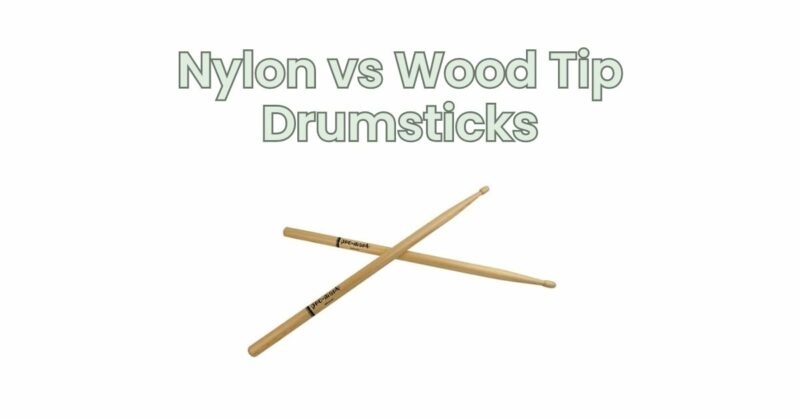Drumsticks are a drummer’s primary tool, and choosing the right pair can significantly impact your playing experience. When it comes to drumstick tips, two popular options are nylon and wood. In this article, we will explore the differences between nylon and wood tip drumsticks to help you make an informed decision based on your playing style, musical genre, and personal preferences.
Nylon Tip Drumsticks: Nylon tips are made from a durable, synthetic material. Here are some key characteristics and considerations of nylon tip drumsticks:
- Increased Definition: Nylon tips provide enhanced articulation and clarity, making them ideal for drummers who want their drumstick attack and cymbal sounds to be more pronounced and defined.
- Brighter Cymbal Tones: Nylon tips can produce brighter cymbal sounds due to their harder and denser surface, resulting in increased stick definition and clarity when playing ride patterns, crashes, or hi-hats.
- Durability: Nylon tips are known for their durability and longevity compared to wood tips. They are less prone to chipping or breaking, which makes them a reliable choice for heavy hitters or drummers who play with a lot of intensity.
- Consistent Sound: Nylon tips offer a more consistent sound quality as the tips don’t wear down as quickly as wood tips. This can be particularly advantageous for drummers who desire consistent tone and feel throughout their performances.
Wood Tip Drumsticks: Wood tip drumsticks are the traditional choice and are typically made from hickory, maple, oak, or other woods. Here are some key characteristics and considerations of wood tip drumsticks:
- Warmer and Softer Sound: Wood tip drumsticks tend to produce a warmer and softer sound compared to nylon tips. The wood tip’s softer impact on cymbals can result in a slightly more mellow and rounded tone.
- Natural Feel and Rebound: Many drummers prefer the natural feel and rebound offered by wood tip drumsticks. The wood tips have a tactile response that allows for a comfortable grip and a familiar playing experience.
- Versatility: Wood tip drumsticks are versatile and suitable for various musical genres. They offer a balanced sound that can adapt to different playing styles and dynamics.
- Tonal Variations: Different wood types used for drumstick construction can contribute to slight tonal variations. For example, hickory is known for its durability and balanced tone, while maple offers a lighter feel and slightly brighter sound.
Choosing the Right Option: Selecting between nylon and wood tip drumsticks ultimately depends on your personal preferences, playing style, and musical context. Consider the following factors when making your choice:
- Playing Style and Musical Genre: Nylon tips may be more suitable for drummers who play louder, heavier music genres or require greater stick definition. Wood tips are often favored by drummers who prefer a softer touch, subtle cymbal response, or play in more diverse musical settings.
- Drum and Cymbal Selection: Consider the specific drum and cymbal setup you use. Experiment with both nylon and wood tips to see how they interact with your specific equipment, as different combinations can yield different sonic results.
- Personal Preference: Ultimately, personal preference plays a significant role in choosing drumsticks. Take the time to try out different sticks and tips to determine which feel, sound, and response resonate with you and enhance your playing style.
- Consider Having Both: Many drummers choose to have a selection of both nylon and wood tip drumsticks to suit different playing situations. This allows for flexibility and the ability to adapt to various musical requirements.
Whether you opt for nylon or wood tip drumsticks, both options have their unique characteristics and advantages. Nylon tips offer increased definition, durability, and brighter cymbal tones, while wood tips provide a warmer sound, natural feel, and tonal versatility. Experimentation and personal preference should guide your choice, and don’t hesitate to have a collection of both types to cater to different musical contexts. The right drumsticks can elevate your playing experience and help you achieve the desired sound and feel behind the kit.


